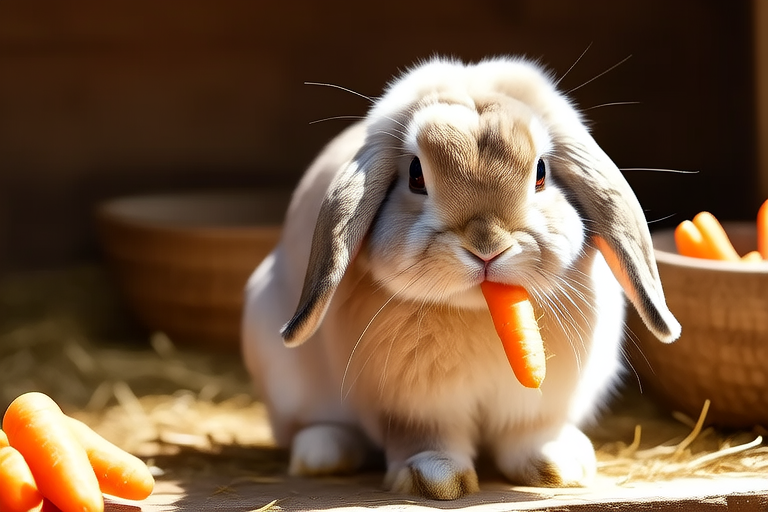Top Tips for Raising Happy and Healthy Lop Bunnies at Home
Welcome to the world of lop bunnies! These adorable, floppy-eared companions have won the hearts of many pet lovers. Whether you’re a first-time bunny owner or a seasoned caretaker, this guide will provide you with essential tips to ensure your lop bunnies lead happy and healthy lives. From understanding their dietary needs to setting up the perfect habitat, we’ve got you covered.
Understanding Your Lop Bunny
Lop bunnies are known for their large, drooping ears, which can be either long or short. They come in various breeds, such as English Lops, French Lops, and Dwarf Lops, each with unique characteristics. One of the most endearing traits of lop bunnies is their gentle nature, making them excellent pets for families with children. However, it’s important to remember that every bunny is an individual with its own personality and preferences.
Dietary Needs
Feeding your lop bunny the right diet is crucial for their overall health. A balanced diet consists of hay, fresh vegetables, and a small amount of pellets. Timothy hay should make up the majority of their diet, as it aids in digestion and keeps their teeth healthy. Fresh vegetables like carrots, spinach, and broccoli should be offered daily, but in moderation. Avoid feeding your bunny too much fruit, as it’s high in sugar.
Real-life example: Sarah, a bunny owner, noticed her lop bunny was gaining weight. After consulting a veterinarian, she realized that she had been overfeeding her bunny with pellets. She adjusted the diet to focus more on hay and fresh vegetables, and her bunny soon returned to a healthy weight.
Exercise Needs
Like all bunnies, lop bunnies need regular exercise to stay fit and active. Providing a spacious indoor or outdoor enclosure allows them to hop, run, and explore. Daily playtime outside of their enclosure is also beneficial. Ensure the play area is bunny-proofed, free from toxic plants, and has no gaps where they could escape.
Real-life example: John, who owns two English Lop bunnies, created a large play area in his backyard. He ensures it’s secure and provides toys for his bunnies to chew on. His bunnies love their outdoor time and are much more active and playful when they get to stretch their legs.
Habitat Setup
The right habitat setup is essential for your lop bunny’s comfort and well-being. Start with a spacious cage that allows plenty of room for movement. Line the bottom with absorbent bedding, such as paper-based products or recycled paper. Provide hiding spots, such as cardboard boxes or tunnels, to give your bunny a sense of security. Ensure good ventilation and avoid placing the cage in direct sunlight or near drafts.
Real-life example: Emily, a bunny owner, found that her lop bunny loved having a cozy hideaway made from a soft towel placed in one corner of the cage. This gave her bunny a safe space to retreat to when feeling overwhelmed.
Grooming Tips
Grooming is an important aspect of caring for your lop bunny. Regular brushing helps remove loose fur and prevents matting, especially during shedding seasons. Pay special attention to their ears, as they can accumulate dirt and debris. Use a damp cloth to gently clean the inside of the ears. Trim their nails if necessary, but be careful not to cut into the quick, which can cause bleeding.
Real-life example: Mike, who has a French Lop, noticed that his bunny’s nails were getting too long. He learned how to trim them safely and now does it regularly. His bunny is much more comfortable, and he enjoys the bonding time they spend together.
Common Health Issues
Despite proper care, lop bunnies may still face certain health issues. Dental problems are common, as rabbits’ teeth grow continuously. Signs of dental issues include difficulty eating, drooling, and weight loss. Regular veterinary check-ups can help catch these issues early. Ear infections can also occur due to the large, floppy ears. Symptoms include redness, swelling, and discharge. Keep an eye out for any changes in behavior or appearance and consult a veterinarian if you suspect a problem.
Real-life example: Linda, a bunny owner, noticed her lop bunny was not eating properly and seemed lethargic. She took her bunny to the vet, who diagnosed a dental issue. After treatment, her bunny quickly recovered and was back to normal.
Bonding with Your Lop Bunny
Building a strong bond with your lop bunny takes time and patience. Spend quality time with your bunny daily, offering treats and gentle handling. Allow them to approach you at their own pace, and respect their boundaries. Some bunnies may take longer to warm up to their owners, so be patient and consistent. Positive reinforcement, such as offering treats and praise, can encourage good behavior.
Real-life example: Mark, who adopted a young lop bunny, found that his bunny was initially shy and would hide when approached. He started by offering treats through the cage and gradually built trust. Over time, his bunny became more confident and now enjoys cuddling and playing with him.
Conclusion
Raising happy and healthy lop bunnies requires dedication and love. By providing a balanced diet, ample exercise, and a comfortable habitat, you can ensure your bunny leads a fulfilling life. Regular grooming and veterinary care are essential for maintaining their health, while spending quality time together helps strengthen your bond. Remember, every bunny is unique, so take the time to understand your pet’s individual needs and preferences. With the right care and attention, your lop bunny will bring joy and companionship to your home for years to come.
